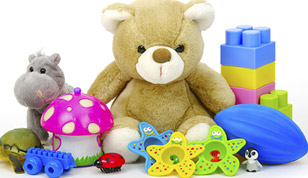Blog Categories
Search Blog
Blog Categories
Picking Toys that Foster Language Development
Play is an essential tool for language development. During play, children learn to express their thoughts and ideas and use language to communicate their needs and wants. They also practice essential social interaction skills such as how to get along with others and to resolve conflicts. When picking toys for children, select toys and games that will help foster language skills. Pick toys that encourage some or all of the following;
Eye Contact: Look for toys that encourage face to face interaction. Children gain much communication information both about social interaction skills and about oral motor movements by looking at communication partners. Examples include: puppets or masks, Peek a boo, hide and seek, silly faces games, or even bubbles. Alternately toys that have faces/characters help teach information about facial expression and other social cues.
Flexibility: Toys that can be used in a variety of ways encourage creativity and the use of new language patterns to express these changes. Some long time favourites include: blocks, Lego, cardboard boxes, etc.
Pre-Language Skills: Imitation, turn taking, and cause and effect skills are essential building blocks for functional communication. Picking toys that foster these skills will help build the foundation for language. Ball play (i.e. rolling or throwing it back and forth) emulates the turn taking of conversation, copying activities such as banging on a drum demonstrates imitation skills, action/reaction toys like pop up toys, jack in the box teach cause and effect.
Imaginary Play: Activities that allow children to role play or extend imaginary play sequences offer endless language building possibilities. Some examples include: Pots and pans, play food, doctor set, play farms, zoos, and doll houses.
Specific Teaching: Toys and games that teach vocabulary or specific language concepts through play such as opposite puzzles, sequencing games, or vocabulary specific memory games are great tools to help build communication skills. Remember these should be fun and not solely a “drill” activity in order for a child to successfully generalize these skills into everyday use.
Getting and Giving Information: Toys that provide opportunities to listen and/or describe or direct help children learn to generate new language and to attend to verbal information. Some examples include games like Twister, Hullabaloo, Pictionary, Guess who, or Simon Says.
Creativity: Toys that stimulate exploration or creativity such as play dough, craft supplies, magnets, or gears offer children lots of opportunities to generate new and different thoughts and ideas or to use language to access their needs/wants (e.g., Can I have glue?).
Remember, your child needs you or another partner to engage with them to facilitate language in play. Whenever you can, put away the distractions and become an active play partner. Having fun is the best way to make language meaningful.






